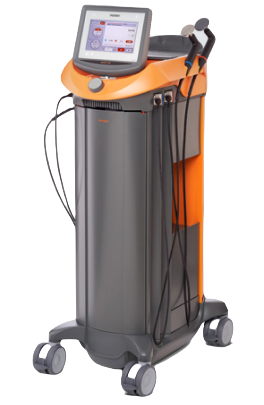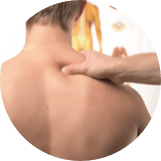The myofascia is a network of thin tough connective tissue that encases muscles and organs throughout your body, enabling soft tissues, bones, organs and neural bodies to glide freely among other structures during movement. When fascia tissue is injured or subjected to excessive force loads, it can become dense and develop sticky adhesions or trigger points that cause pain and inhibit fluid movement.
At NYDNRehab, myofascial release techniques and trigger point dry needling team up with diagnostic ultrasound and advanced regenerative technologies to promote healthy fascia and restore pain-free movement.
or
Dr. Kalika’s path to expertise in treating myofascial disorders began in 1998, when he moved to Prague to be mentored by two of the world’s foremost pioneers in human movement science: prof Vladimir Janda MD PhD, and prof Karel Lewit MD PhD, the inventor of dry needling.
Dr. Kalika later went on to become an expert in diagnostic musculoskeletal ultrasound. He began to use ultrasound imaging to guide dry needling procedures, and he has published multiple scientific papers on the topic. He is considered one of the world’s top experts in ultrasound guided procedures.
Dr. Kalika’s extensive work with patients has led him to pursue the latest techniques for optimizing patient outcomes. He is certified in the Stecco Method of fascial manipulation therapy, with many years of experience in the approach, enabling him to better address the fascial component of myofascial pain syndrome.
Dr. Kalika uses diagnostic ultrasonography to clearly visualize the structural components that contribute to myofascial pain. In his 25 years of experience in treating patients with myofascial pain syndrome, he discovered that trigger points are only an expression of a greater underlying musculoskeletal condition.
Dr. Kalika uses ultrasound guided dry needling to relieve trigger points, a procedure for which he has published research and gained widespread recognition. Dry needling procedures and trigger point injections performed “blind” without ultrasound imaging only treat the symptoms, without resolving the underlying cause of trigger points.

The role and function of myofascial tissue has only recently gained widespread attention from researchers, and many practitioners have a poor understanding of how fascia tissue integrates with other structures to optimize human movement.
Dr. Kalika got a head start on fascial treatment, thanks to his mentorship from early pioneers. While other practitioners are only now learning about fascia, Dr. Kalika has had several years of hands-on experience to fine-tune his own unique approach to myofascial treatment.
Oftentimes, fascia adhesions and trigger points need to be addressed before beginning physical therapy, to ensure optimal results. Diagnostic ultrasound imaging gives us a clear real-time picture of how fascia interacts with other structures, enabling us to identify adhesions and trigger points that cannot be palpated from the skin’s surface.
Our personalized one-on-one approach to patient care, along with our proprietary treatment protocols, make NYDNRehab the clinic of choice for myofascial pain treatment and trigger point therapy in NYC.
Diagnosis of myofascial densifications, adhesions and trigger points requires an in-depth knowledge of fascia and the underlying process of fascia densification. Many practitioners lack the education or experience to properly interpret fascia densification from a clinical perspective, and misdiagnosis is common.
Myofascial pain syndrome is often misdiagnosed as fibromyalgia, but the two conditions have distinct characteristics. Myofascial pain is localized in specific muscles, while fibromyalgia pain is widespread throughout the body. Trigger points are not a feature of fibromyalgia, although fibromyalgia patients may also have myofascial pain syndrome, making it critical to differentiate between the two.
At NYDNRehab, we use the highest resolution ultrasonography equipment to view the fascia and its interactions with other structures in real time. Ultrasound imaging gives us a clear picture of trigger points and adhesions that interfere with movement. Our research-grade equipment also gives us capabilities for sonoelastography, to detect and measure fascia densifications.

In recent years, mainstream fascia manipulation techniques performed by untrained practitioners have become a sort of fad that promises — but fails to deliver — a cure-all remedy for musculoskeletal pain.
When performed by a trained professional who understands the fundamental properties of fascia and the role it plays in human movement, fascia manipulation therapy is an evidence-based and reliable methodology that restores the integrity of fascia tissue.
Myofascial treatment approaches at NYDNRehab include:
Focused extracorporeal shockwave therapy (ESWT) uses sound wave technology to produce several regenerative and pain-mediating effects, including:
Neovascularization
Release of growth factors such as TGF-1, VEGF
Stimulation and proliferation of fibroblasts
Stimulation of mesenchymal stem cells
Antibacterial effects
Promotion of local circulation
Suppression of pro-inflammatory mediators
Direct effect on peripheral nerves
TECAR therapy dramatically speeds up tissue healing by normalizing electrical charges within damaged cells. When combined with Stecco manipulation therapy, TECAR works to accelerate fascia healing and restore its integrity.

INDIBA Radiofrequency Therapy

Myofascial trigger points often contribute to fascia pain. Dry needling is an outpatient procedure where thin non-medicated needles are inserted into myofascial trigger points to evoke a twitch response that releases contractile nodes. Ultrasound guidance eliminates the need for multiple insertions, reducing pain and discomfort for the patient.
Hydrodissection is a technique for treating peripheral nerves entrapped by densified fascia. It involves injecting a saline solution, to separate entrapped nerves from surrounding fascia and adjacent structures.


It can be tempting for clinicians to simply find pain generators, movement restrictions or weak muscles and treat them as independent entities.. But the human body is an integrated system of interrelated structures, and myofascial issues can cause altered movement patterns that create complex structural and functional problems.
Resolving myofascial pain and dysfunction requires strategically planned and multifaceted intervention by a knowledgeable practitioner. There are plenty of therapists willing to provide myofascial manipulation without fully understanding the nature and function of fascia tissue, leaving patients with unresolved issues that can cause pain, reduce mobility, and create structural and functional complications.
At NYDNRehab, we use the most advanced diagnostic ultrasound to get a full picture of your fascia and how it interacts with other structures, to provide personalized care that restores fascia integrity and eliminates trigger points.
Don’t waste your time and money on ineffective treatment approaches that target symptoms without resolving their underlying cause. Contact NYDNRehab today, and get the most advanced myofascial therapy available, so you can move freely without pain or restrictions.
Dr. Lev Kalika is a world-recognized expert in musculoskeletal medicine. with 20+ years of clinical experience in diagnostic musculoskeletal ultrasonography, rehabilitative sports medicine and conservative orthopedics. In addition to operating his clinical practice in Manhattan, he regularly publishes peer-reviewed research on ultrasound-guided therapies and procedures. He serves as a peer reviewer for Springer Nature.
Dr. Kalika is an esteemed member of multiple professional organizations, including: